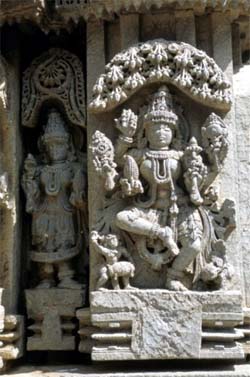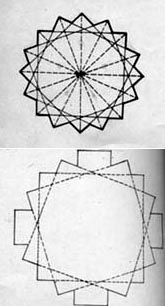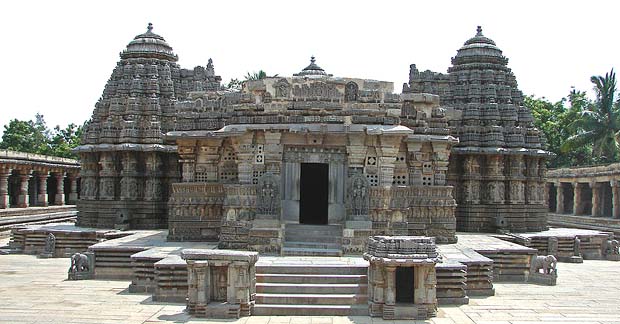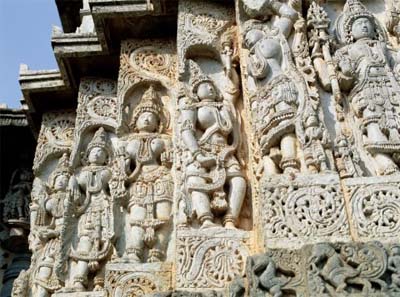Dec 31, 2025
Dec 31, 2025
 The flourishing temple styles in North India - both the Khajuraho and the Orissi versions - were brought to a rude end with the Muslim invasion. When the Muslims consolidated their hold over North India, temple-building activity virtually stopped. Entire families of skilled craftsmen were now presented with two choices - the first of which was to work for their new masters and abandon the idea of building a temple as an offering to God. This resulted in the fusion of Persian and Indian building styles and was to result in an entirely new idiom, as we shall see later.
The flourishing temple styles in North India - both the Khajuraho and the Orissi versions - were brought to a rude end with the Muslim invasion. When the Muslims consolidated their hold over North India, temple-building activity virtually stopped. Entire families of skilled craftsmen were now presented with two choices - the first of which was to work for their new masters and abandon the idea of building a temple as an offering to God. This resulted in the fusion of Persian and Indian building styles and was to result in an entirely new idiom, as we shall see later.
Another option was to migrate further and further south, in search of work and new patrons, where Muslim influence had not yet made inroads. This was the region around modern Mysore, where the hitherto unknown Hoysala tribe was making its first moves towards glory. Having overthrown their former overlords, the Cholas, the Hoysalas were in no mood to imitate their architectural style and were looking for something with its own distinct identity. The craftsmen migrating from the north were able to provide just such an impetus.
The merging of the Dravidian and North Indian styles created a temple that is unique, so much so that it is often classified as the Hoysala style. The early experiments were found on the extreme edges of the kingdom, around ancient Dwarasamudra. The profile of the temples at Ittagi, Gadag and Lakhundi reveals that the craftsman's most visible contribution was a subtle merging of the two spire forms - the horizontal tiers of the pyramidal south Indian vimana and the round-shouldered elegance of the northern shikhara.
 Gradually this hybrid evolved into an identifiable style, rivaling in grace and beauty its predecessors.
Gradually this hybrid evolved into an identifiable style, rivaling in grace and beauty its predecessors.
The Star in Plan
To add to its distinctiveness, the Hoysala temple in plan composed of numerous cellas or garbha-grihas served by a common mandapa. The plan of each of these cellas was a star. The departure from the accepted square form of the temple is understandable when we analyze the plan and see that it is made up of a grid of rotating squares. The resulting outline thus emerges as a star. The mandapa remained a square, though it was now distinguished by circular columns, the shafts of which had been lathed and thus acquired a number of parallel knife-edges.
Among the examples of the developed Hoysala style, the Chenna Kesava temple at modern Belur is one of the finest. This was designed and planned by the architect Janaka Acharya at the behest of King Vishnuvardhan.

Though built around a single shrine, the temple has all the distinguishing features of the Hoysala style - a pillared mandapa, bell-shaped towers and above all the star-shaped plan. The gaps between the outer pillars were covered with a jaali meant to provide privacy for the Brahmins, and especially the 'highly seductive dancing of the devdasis'.*
The mandapa of this temple has an extremely beautiful circular stone platform, lustrously polished after years and years of dance on it - the ritualistic, devotional Bharata Natyam of the South.
Splendor in Halebid
 Not content with this little gem in Belur, the king commissioned an even larger and more magnificent temple in his new capital city of Halebid. The architect proceeded to lay out two identical temples, parallel and connected at their transepts.
Not content with this little gem in Belur, the king commissioned an even larger and more magnificent temple in his new capital city of Halebid. The architect proceeded to lay out two identical temples, parallel and connected at their transepts.
The Halebid temple is one of the most fitting climaxes to the sculptor's art in India. While architecturally it was not revolutionary, especially after Belur, it is in its rich sensuous sculpture that this example comes into its own. The high plinth of the temple is a virtual tapestry of sculpture, with bands of dancing figures, animals, vegetation and other objects coming to life on its surface.
According to Percy Brown, the 'Halebid Temple and the Parthenon are probably the two extremes of the architectural art of the world'. 'The one revels in the cold purity of its form and the other in the warm complexity of its sculptural architectonics'.**
The Last Chapter
The Hoysala temples were among the last temples of consequence to be built in India. Muslim invasions were fast taking their toll and kings were more concerned about fighting off the invaders than with artistic and architectural endeavors.
However, the Vijayanagara empire further south held on a little bit longer. The marvels at Hampi are the last examples of mediaeval Hindu architecture we shall discuss - in the next column.
* Grover, Satish The Architecture of India - Buddhist and Hindu, Vikas Publishing House Pvt. Ltd. , New Delhi, 1980.
** ibid
Images under license with Gettyimages.com
23-Jun-2001
More by : Ashish Nangia

|
' This was designed and planned by the architect Janaka Acharya at the behest of King Vishnuvardhan. - ' The correct name of the master Sculptor is JAKANACHARYA not Janaka Acharya as scripted in your article. Please recheck,confirm and correct the name |

|
its very helpful for my literature study... |

|
very informative and well-written |